The AMD Trinity Review (A10-4600M): A New Hope
by Jarred Walton on May 15, 2012 12:00 AM ESTAMD Trinity Gaming Performance
After the 3DMark results, you might be wondering if Intel has finally caught up to AMD in terms of integrated graphics performance. The answer is…yes and no. Depending on the game, there are times where a fast Ivy Bridge CPU with HD 4000 will actually beat out Trinity; there are also times where Intel’s IGP really struggles to keep pace. The good news is that at least everyone is now onboard the DX11 bandwagon, and compatibility with games has improved yet again for Intel. Here are our “Value” benchmark results for seven recent games; we’ll have more information in a moment.

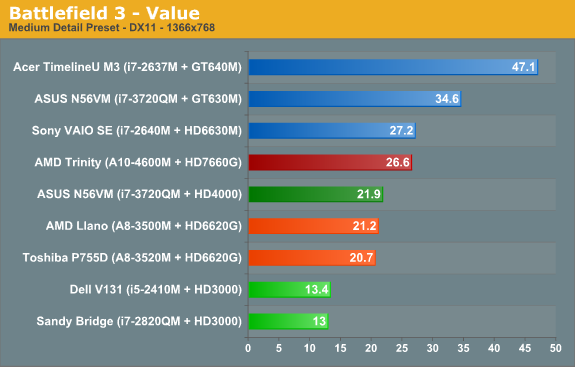
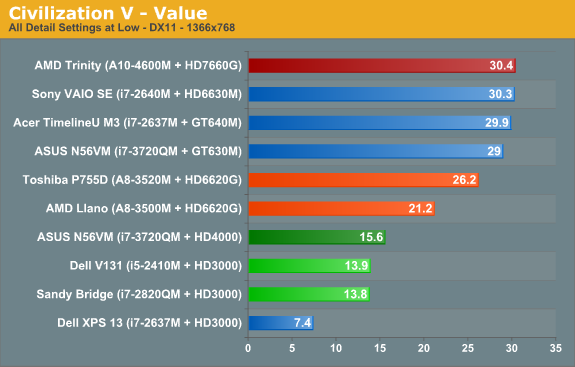

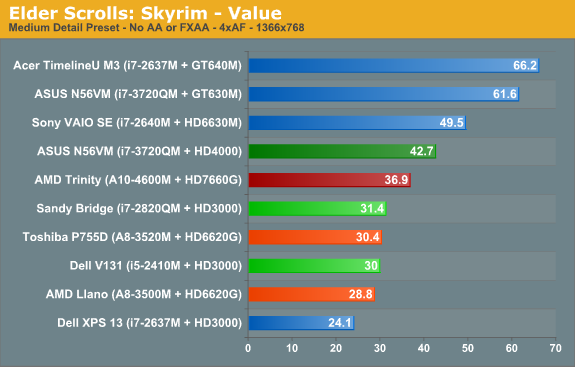
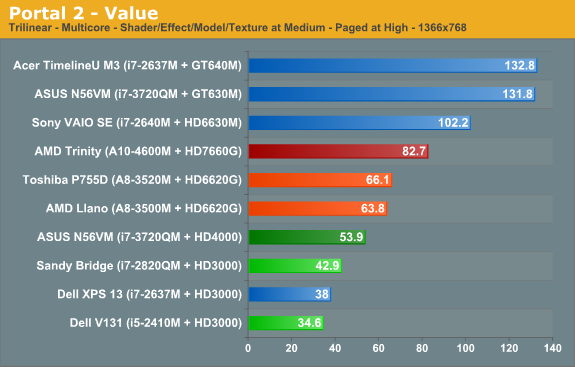
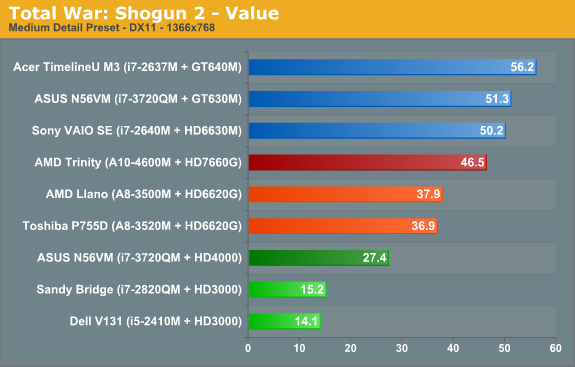
Out of our seven test titles, AMD’s Trinity leads any other IGP in four titles by a large margin. The other three titles actually have Ivy Bridge slightly ahead of Trinity, but the gaps aren’t nearly as big. Overall, the average performance across the seven games at our Value (medium) settings has AMD’s Trinity A10-4600M leading Intel’s i7-3720QM by 21%, and if we look at quad-core Sandy Bridge with HD 3000 (i7-2820QM) Trinity is 72% faster. Trinity is also around 20% faster than 35W Llano on average.
Let’s expand our gaming suite just a bit to see if things change, though. Just like we did with Ivy Bridge, we ran the eight games in our previous benchmark suite at medium detail settings. We can then compare performance across a wider 15 title selection to see how Trinity matches up against HD 4000, HD 3000, and HD 6620G (Llano). We’ll start with the bottom (HD 3000/Sandy Bridge) and move up.
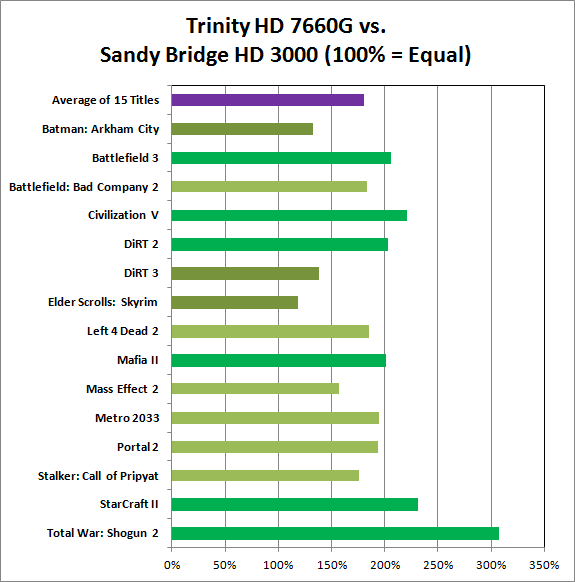
Llano’s HD 6620G was already faster than HD 3000, and Trinity’s HD 7660G is faster than Llano, so the Sandy Bridge gaming matchup is a landslide victory in AMD’s favor. The closest Intel can get is in the same three titles where Ivy Bridge leads Trinity: Batman: Arkham City, DiRT 3, and Skyrim. Here, however, HD 3000 can’t actually close the gap and HD 6620G is at least 20% faster than HD 3000, with an average performance improvement of nearly 80%.
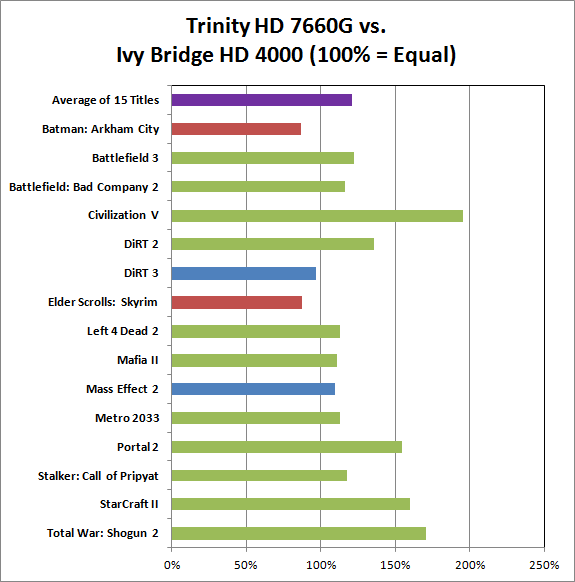
We found that across the same selection of 15 titles, Ivy Bridge and Llano actually ended up “tied”—Intel led in some games, AMD in others, but on average the two IGPs offered similar performance. This chart and the next chart will thus show a similar average increase in performance for Trinity, but the details in specific games are going to be different. Starting with Ivy Bridge and HD 4000, as with our earlier game charts we see there are some titles where Intel leads (Batman and Skyrim), a couple ties (DiRT 3 and Mass Effect 2), and the remainder of the games are faster on Trinity. Mafia II is close to our <10% “tie” range but comes in just above that mark, as do Left 4 Dead 2 and Metro 2033. The biggest gap is Civilization V, where Intel’s various IGPs have never managed good performance; Trinity is nearly twice as fast as Ivy Bridge in that title. Overall, it's a 20% lead for Trinity vs. quad-core Ivy Bridge.
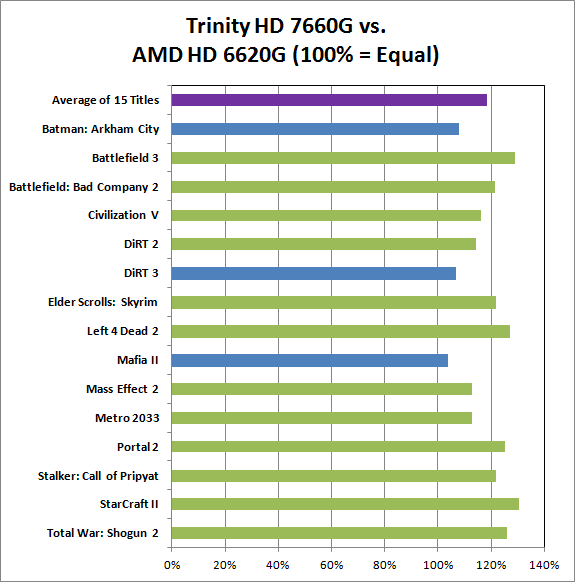
Against Llano, Trinity is universally faster, but the smallest gap is in Mafia II (3%) while the largest gap is in StarCraft II (30%). On average, looking at these games Trinity is only 18% faster than Llano. What’s not entirely clear from the above chart is whether we’re hitting CPU limitations, memory bandwidth limitations (remember that Llano and Trinity share bandwidth with the rest of the system), or perhaps both. At our chosen settings, what is clear is that Trinity’s “up to 56% faster” graphics never make it that high.
We saw 35-45% higher scores in 3DMark 11 and Vantage, which tend to remove the CPU from the equation more than actual games, so our guess would be that if AMD continues with their APU plan they’re going to need to work more on the CPU side of the equation. We also see the same thing looking at the VAIO SE scores in the earlier gaming charts: the HD 6630M scores are 20% faster on average, but much of that appears to come from the faster CPU rather than the GPU.










271 Comments
View All Comments
medi01 - Thursday, May 17, 2012 - link
Half of CPU performance, but better GPU performance and power consumption.And I doubt that for an average consumer the first matters more than the latter.
wsaenotsock - Tuesday, May 15, 2012 - link
I mean to summarize all of this, it's a low performance processor with average graphics performance (comparing to an i7 and a discrete GPU), with above average battery life. I think with the right pricing AMD can put out a great rounded mobile product. The best thing it has going for it needs to be the price since it doesn't really lead the pack in any other area. I bought a Zacate netbook and I found it very useful for the price.I wonder if a few generations from now, AMD can begin to outperform CPU + discrete GPU's with it's combined APU chips, or at least on a per-watt basis really deliver uncomparable performance. That would really make the AMD fusion platform a new beast but it doesn't seem ready for that yet. Still it must be a goal for AMD and it is really one that will become more important as time goes on with computing solutions miniaturizing every year.
Denithor - Tuesday, May 15, 2012 - link
They won't ever surpass CPU + discrete GPU for one simple reason: TDP.You simply cannot match the performance of a 75-100W CPU + 100-200W GPU with a 75-100W APU.
Kaggy - Tuesday, May 15, 2012 - link
Any chance of Windows 8 comparison someday, just curious.Kaggy - Tuesday, May 15, 2012 - link
i meant processor comparison on windows 8EyelessBlond - Tuesday, May 15, 2012 - link
I'm wondering how the memory clocks are affecting Trinity performance. We saw with Llano that the processor was memory constrained, such that you saw a significant improvement with DDR3 1866 as opposed to DDR3 1600; now that the chip is shuffling bits even faster I'm curious to see if more memory throughput (triple channel DDR3, the new DDR4, or even a relatively simple memory overclock) can boost APU performance even more with these new chips.JarredWalton - Tuesday, May 15, 2012 - link
Officially, mobile Trinity only supports up to DDR3-1600, which is what we have for testing. The clocks on the desktop version will likely be higher, making more bandwidth potentially useful, but unfortunately we can't test anything higher than DDR3-1600 on Trinity. And as an aside, I tried using DDR3-1600 with the Llano laptop, only to find that the BIOS won't allow anything higher than DDR3-1333 speeds. I wouldn't be surprised if this prototype Trinity laptop is the same way with regards to RAM speeds -- the BIOS on this sort of laptop is always pretty bare.Khato - Tuesday, May 15, 2012 - link
Does the prototype Trinity laptop BIOS support running the memory at DDR3-1333? That would at least offer an indication of whether certain benchmarks are memory bandwidth limited or not which would then imply whether or not higher memory frequency actually would help. Would also be interesting to see performance with just single channel memory seeing as how all too many manufacturers are still shipping laptops with that configuration.JarredWalton - Tuesday, May 15, 2012 - link
I don't think so, but I can always stick in DDR3-1333 RAM if needed. Might be interesting, but you'll have to wait a day or two for me to get something like that tested.Khato - Tuesday, May 15, 2012 - link
Good idea, so long as it doesn't either overclock the memory to 1600 anyway or simply refuse to boot, haha. Hopefully it'll work though since I'm quite curious to see the results! It'll not only give us an idea of whether higher speed memory will help, but also how much of a hit the lesser versions of the iGPU on the other SKUs will take.